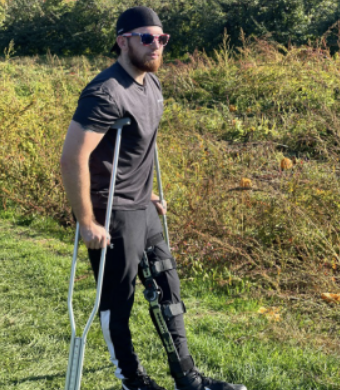Students, faculty troubled by accessibility problems

Kevin Foley weighs in on accessibility
November 17, 2022
Concerns are emerging over the misuse and lack of handicap accessibility as the college continues to find ways to make buildings more accessible for students, faculty, and guests.
Addressing accessibility is a very difficult project according to Jonathan Woodcock, director of physical plant and overseer of Capital Planning and Project Management for the college. Woodcock noted, “The Hilltop is a tough place to wage a war on physical accessibility. When it comes to our terrain, the ability to facilitate proper walking paths and transitions is tough at best.”
One of the most significant issues being raised is a growing abuse of handicap accessibility already in place in many buildings. Senior Kevin Foley tore his meniscus last May and has been recovering from surgery on crutches since September. Foley has observed this problem first-hand.
Foley focused on the abuse of physical measures already in place, stating, “The problem is that people who don’t need it use it because they don’t want to use the stairs. This fills the elevator and often makes me late to class.” Handicap buttons in buildings such as Davison Hall and behind Alumni Hall have also been overused, wearing out the system so it doesn’t work when someone needs it.
Additionally, a few academic buildings still lack proper accessibility measures from the ADA. After some investigation from the Crier, it was found that Joseph Hall has a ramp leading to the basement, but lacks accessibility to other floors without the use of stairways. Similarly, NHIOP has no handicap door entrances, and Poisson Hall has no handicap access to the second floor. Dormitories such as Dominic Hall, JOA, Alumni Streets, and Hilary Hall, the only way to access dorm rooms on the second or third floor is by using a stairwell. This poses a significant problem for emergency situations and response times for the EMS team and first responders.
Laura Abernathy, the college EMS captain, expressed how the narrowness of hallways and stairways make it extremely difficult to move patients into an ambulance during an emergency. “A lot of times, the patient is not in the conditions to be able to walk for themselves. When this happens, we use a stair chair to get students from other floors outside. However, it is difficult because we need to get the patient up, strap them in the chair, and man them downstairs with about four people. God forbid if you drop the chair or they fall down the steps. It makes it challenging to respond quicker to certain situations.”
According to the Americans with Disabilities Act of 1990, all new buildings must be made accessible to handicapped population, but there are exceptions granted for buildings where accessibility cannot be made readily achievable or will have a great cost of expense. Similarly, the Federal Fair Housing Act of 1988 covers construction on any new building projects, but does not cover renovations to buildings created before 1988.
Since NHIOP, Joseph Hall, Poisson, and many of the dormitory buildings were built prior to the bills, the college is not required to make them accessible due to the amount of money it would cost.
However, the school has made progress in accessibility measures recently. According to Dr. Sue Weintraub, the Dean of Res Life, students that need living accommodations are reviewed on a case-by-case basis, particularly for housing on-campus. Dr. Weintraub emphasized that students who are injured are often accommodated by being placed on the first floor of a residential hall building.
Woodcock also noted how the college is working towards addressing issues of accessibility around campus. “In new facilities like the LLC, Jean Student Center, Savard Welcome Center, or the new Humanities Institute, we have incorporated ADA code into the design and function of the buildings. On existing facilities, we have installed tip downs and cross walks across campus, push button ADA entrances where applicable, modifications or additions to ADA parking, etc.”
Going forth, Woodcock noted how upcoming projects such as the Humanities Institute and a Dominic Hall interior renovation will address ADA concerns. Future projects will also include the nursing and health sciences building, track and field complex, and JOA interior renovations.
Foley recommended that students walk up stairs in places like Alumni Hall if they are not handicapped. “Don’t abuse what we have in place. Walking up the stairs is good but if it hurts to use your legs, then you should use the elevator. It is a significant indecency when you abuse those things.”
Director of Campus Safety Rob Browne also noted that students should be respectful of parking around campus. Brown stated that his biggest concern is “when people park in fire lanes, block egress to roadways and park in unauthorized areas.”


